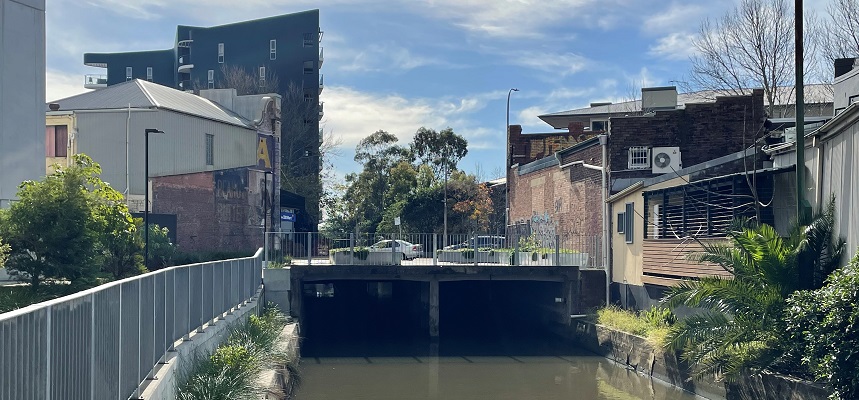
History of the Cottage Creek bridge, Hunter Street

Did you know there is a bridge under Hunter Street in Newcastle West? You might drive over it every day and not realise.
History of the bridge location
The Awabakal and Worimi peoples are descendants of the traditional custodians of the land situated within the Newcastle local government area, including wetlands, rivers, creeks and coastal environments. It is known that their heritage and cultural ties to Newcastle date back tens of thousands of years.
Muluubinba is the traditional name for the people. Its name is attributed to a local sea fern that was traditionally harvested as a food crop. In breaking down the word, it translates to: ‘muluu’ the name of the sea fern ‘bin’ is plural and ‘ba’ place of meaning - the place of many sea ferns. This area is where the modern-day Foreshore, Honeysuckle and CBD are currently situated.
A convict settlement was established at Newcastle in 1801 and, from then until 1821, the area was run as a convict settlement with development limited to the area east of Church Hill – apart from a government farm located near Honeysuckle Point. This farm was notable for having a ‘neat cottage’ on it and the nearby creek became known as 'Cottage Creek'.
Construction of the bridge
Early history of the bridge itself is unclear. Heritage consultants engaged by City of Newcastle reviewed a range of historic plans of the area. They determined that there has been a bridge in this location across Cottage Creek at Hunter Street for a considerable time, as detailed below.
In 1887 a steam tram line from Newcastle to Plattsburg (near Wallsend) was opened, with the route along Hunter Street and over Cottage Creek, and it is believed that a concrete bridge was in place at that time.
In 1892 a proposal was developed by the Department of Public Works to construct a covered sewer from the Throsby Creek Junction upstream to the coal railway bridge over Cottage Creek (which was located roughly near King Street).
Department of Lands plan drawings located by the Heritage Collections Librarian at Newcastle Library detail the bridge's location in 1896.

Department of Lands survey, 1896 - View a larger PDF version.
 Cottage Creek stormwater drain under construction, upstream of Hunter Street – Ralph Snowball, 1896
Cottage Creek stormwater drain under construction, upstream of Hunter Street – Ralph Snowball, 1896
Cottage Creek stormwater drain under construction, upstream of Hunter Street – Ralph Snowball, 1897
On 24th June 1897 Sydney Morning Herald reported that “plans and specifications for extending the Cottage Creek Bridge to the full width of Hunter-street were submitted by the city engineer. The matter was referred to the improvement committee.” Sydney Morning Herald reported later that, "the city council has decided to proceed with the construction of the new bridge spanning Cottage Creek in Hunter Street West." On the 3rd September 1900, Sydney Morning Herald announced that “the work of constructing the new bridge to span Cottage Creek at Hunter Street West has been commenced. The cost of the new structure will be about £1000, which will be equally born by the Government, the Railway Commissioners, and the Newcastle Council”.
In 1927, further widening of the channel from 20ft to 30ft, and the construction of a duplicate channel was undertaken through a NSW Public Works Department scheme. There was also suggestion by John Shine, Newcastle Council Engineer, that the channel should be covered at Hunter Street to allow for the construction of shops along the Hunter Street frontage. Once the Scheme was completed it was transferred to the Hunter Water District Board in 1930.

A "jack arch" bridge
The form of the older part of the bridge is what is known as a “jack arch”. It predates the use of reinforced concrete and was typically used for constructing fireproof floors in warehouses. There are a number of “jack arch” bridges known in NSW and it is understood that they may have been a common bridge design for rail overbridges from the late 1880s until the 1920s. Most of the bridges over the channels of Cottage and Throsby Creeks are small concrete beam bridges – a simple reinforced concrete design that replaced the “jack arch", making this bridge type uncommon in the Newcastle area.

679A and 681 Hunter Street
The 1930 channel widening included construction of a supported concrete platform on the southern side of the bridge, which enabled the construction of shops at 681 Hunter Street.
Over the years these buildings housed a number of businesses, but over time the condition of the buildings deteriorated.

City of Newcastle purchased the buildings from Hunter Water Corporation in 2018, and in 2019 the buildings were demolished, with the concrete platform remaining in place.
Demolition of the buildings revealed an old advertising sign painted on the wall of the adjacent property at 683 Hunter Street. The building is understood to have been built in 1936, making the blue peanut butter advertisement (believed to be for ETA peanut butter) over 80 years old.












